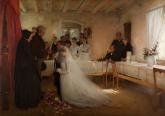Here you can see works of European painting produced in the last few decades ill the nineteenth century in the traditional Realist manner. Realist art in Prance underwent some significant changes in the course of the century, however, and artists of the 1880s and 1890s could not fail to be influenced to some extent by the new artistic devices of the Impressionists, Symbolists and other trends of the day. At a time when Impressionist and Post-Impressionist works Were just beginning to win widespread recognition, the "Realists" were enjoying great success at the Paris Salon and were readily acquired by museums and collectors. In Russia they were purchased by leading patrons and authorities on art, such as Sergei Tretyakov, Dmitry Botkin, Pavel Kharitonenko, Sergei Sluluikin and Mikhail Morozov. Works by French Realists had an enormous influence on the art of other European countries, promoting the renunciation of obsolete academic traditions and revival of painting. A key role in this process was played by the oeuvre of Jules Bastien-Lepage, represented in the display by the picture The Village Lovers (1882), one of his best known works.
In the last third of the nineteenth and the early twentieth century artists often left Paris for the provinces in search of new subjects and fresh impressions. I his resulted in such works as Pascal Dagnan-Bouveret's Nuptial Benediction (1897), Charles Cottet's The Last Supper (1897), Lucien Simon's A Gust of Wind (1901-1905), Leon Lhermitte's Reapers (before 1892) and Jean-Charles Cazin's Village (late 1870s-1880s). In turning to traditional and even archaic subjects, the authors of these works make active use of innovatory artistic language, 'I on bold compositional devices, unexpected foreshortening, free pictorial texture and the fine play of light nuances.
Similar processes, although on a smaller scale, were taking place in the art of other European schools. The Dutch painters Anton Mauve and Jozef Israels, the Belgian artist and sculptor Constantin Meunier, the Hungarian painter Michaly Munkacsy and the German artists Hans von Bartels, Adolf von Menzel and Franz von Lenbach, all represented in the display, were able in some degree or other to be ahead of their time, working in a manner that was closer to the innovatory stylistics of the French school.
The symptomatic boundary between Realist artists and progressive trends in French painting in the last third of the nineteenth century is found in characteristic Paris views. The townscapes by Luigi Loir, Pierre Carridre-Belleuse, Edouard Leon Cortes and Jean Beraud echo certain Impressionist works depicting the French capital.

































